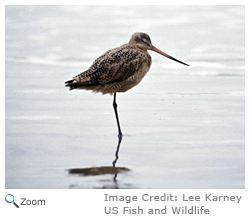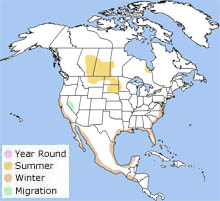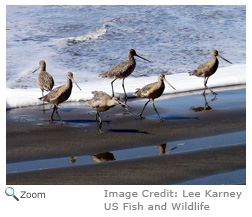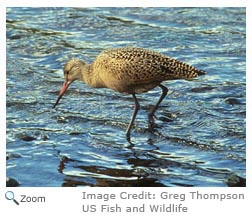Characteristics
 The marbled godwit is 18 inches tall. It has mottled gray, black and brown feathers on its upperside and a lighter color on its underside. The underside of its wings is a rusty-cinnamon brown. It has long legs and a long, upturned bill that is pink at the base and darker towards the end. Males and females are similar in appearance, but the male is a little smaller. The marbled godwit is 18 inches tall. It has mottled gray, black and brown feathers on its upperside and a lighter color on its underside. The underside of its wings is a rusty-cinnamon brown. It has long legs and a long, upturned bill that is pink at the base and darker towards the end. Males and females are similar in appearance, but the male is a little smaller.
Range
 The marbled godwit breeds in the Central Plains region of North America from central Alberta through central Manitoba and along St. James Bay south through Montana, North Dakota, east central South Dakota, and north central Nebraska, and east to north central Minnesota. It winters along the Pacific coast from California south, from Virginia south and along the Gulf Coast. The marbled godwit breeds in the Central Plains region of North America from central Alberta through central Manitoba and along St. James Bay south through Montana, North Dakota, east central South Dakota, and north central Nebraska, and east to north central Minnesota. It winters along the Pacific coast from California south, from Virginia south and along the Gulf Coast.
Habitat
 The marbled godwit breeds on grassy plains, wet meadows and prairies sloughs, usually near rivers or streams. During migration it can be found on coastal beaches and along lake shores. In the winter it can be found in estuaries, salt marshes, tidal creeks, mudflats and ocean beaches. The marbled godwit breeds on grassy plains, wet meadows and prairies sloughs, usually near rivers or streams. During migration it can be found on coastal beaches and along lake shores. In the winter it can be found in estuaries, salt marshes, tidal creeks, mudflats and ocean beaches.
|
|
Diet
 The marbled godwit forages for food by probing in shallow water and soft mud for aquatic insects and mollusks. It also catches grasshoppers and other insects in grassy areas. It may also eat snails, small crustaceans, insect larvae, worms and leeches. The marbled godwit forages for food by probing in shallow water and soft mud for aquatic insects and mollusks. It also catches grasshoppers and other insects in grassy areas. It may also eat snails, small crustaceans, insect larvae, worms and leeches.
Life Cycle
The female marbled godwit lays 4 eggs in a depression lined with grass. The female incubates the eggs. The chicks hatch in 20-22 days. Both the male and female care for the young.
Behavior
Marbled godwits fly in large, noisy groups over the Great Plains in the spring. Males will chase each other and perform elaborate figure-eights in the air.
|